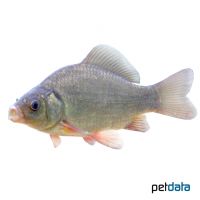Crucian Carp (Carassius carassius)
| Crucian Carp Carassius carassius | |
|---|---|
| Name | Crucian Carp |
| Name Lat. | Carassius carassius |
| Family | Carps |
| Family lat. | Cyprinidae |
| Order | Carps |
| Order lat. | Cypriniformes |
| Origin | Asia, Europe |
| Habitat | Rivers, lakes, ponds |
| Diet | Omnivore |
| pH | 5.0-8.0 |
| Behavior | Peaceful |
| Keeping | Group |
| Care Level | Easy |
| Reproduction | Egg scatterer |
| Breeding | Moderately difficult |
| Life Span | 8-10 years |
| Protection | No |
| Metric Units | |
| Size | 20-40 cm |
| Temperature | 4-28 °C |
| Hardness | 10-30 °dH |
| Aquarium | Ponds |
| US Units | |
| Size | 8"-16" |
| Temperature | 39-82 °F |
| Hardness | 178-534 ppm |
| Aquarium | Ponds |
Distribution and habitat
The crucian carp are widespread from Western Europe to Eastern Siberia. These particularly adaptable and undemanding fish live mostly in plant-rich, stagnant waters such as lakes, ponds, oxbow lakes, ponds and floodplains, but also occur in slow-flowing rivers with dense riparian vegetation and in brackish water.
Maintenance
They require sufficiently large ponds, which should be furnished with pond, floating and oxygenating underwater plants (milfoil, waterweed, hornwort, etc.), large river pebbles and a substrate of round-grained gravel and sand, and provide free swimming space.
No ammonia, ammonium and nitrite should be detectable in the water, and the nitrate level should not exceed 100 mg/l. To ensure the water quality and oxygen content, a filter adapted to the water volume should not be missing.
Diet
They are easy to feed. The food supply consists mainly of commercial special dry food for pond fish, such as flakes, sticks or granules with low protein content (below 30%). In addition, they require plant food, such as aquatic plants (Elodea densa, Cabomba caroliniana, Rizzia flutians, etc.) or scalded leaves (spinach, dandelion) or dry food with high plant content (spirulina). Occasionally live food such as daphnia, cyclops, tubifex and mosquito larvae should be offered, which is also accepted without problems in frozen form.
Regular and varied feeding promotes health and increases resistance.
Behaviour and compatibility
They are calm, peaceful and sociable fish that do not show any aggressive or incompatible behavior. At least 5, but preferably more, crucians should be kept together. A socialization with other peaceful pond fish is well possible.
Basically, only compatible fish species with similar demands on water quality and water temperature may be socialized.
Reproduction and breeding
The sexes are difficult to distinguish. The males are slightly more slender than the females.
Between May and June, at a water temperature of at least 15 °C, the females spawn in the shallow shore zone, where the eggs adhere to plants. After 3-7 days, the larvae hatch and attach to aquatic plants for another 3 days before coming to the water surface to fill their swim bladder with air.
Life expectancy can be 10-20 years.
Important
Crucian carp can fast for long periods, survive in oxygen-poor waters, and briefly, buried in mud, in waters that have dried up
If they are overwintered in the pond, sufficient depth and oxygen supply (filter, oxygen dispenser, ice free holder) must be provided
At temperatures below 10 °C, the metabolism of crucian carp slows down and food is no longer accepted; feeding must be stopped accordingly. If the temperature drops further, they burrow into the mud and go into hibernation. In spring, with rising temperatures, feeding can slowly be resumed. Feeding may also be necessary during prolonged warm periods in winter
The well-being of the fish should be monitored regularly. A regular partial water change, according to the pond size is recommended, even if the pollutant load has not yet reached the upper limit. Sudden changes in water quality should be avoided. Newly introduced fish must be accustomed slowly to the water in the pond.
Further literature can be found in your pet store.
References
Text: Werner Winter; Image: petdata
Source: BMELV (1998): Tierschutzgutachten - Haltung von Zierfischen (Süßwasser); RIEHL & BAENSCH (2006): Aquarien Atlas Bd. 1, Mergus Verlag; ENGELMANN (2005): Zootierhaltung - Tiere in menschlicher Obhut: Fische; Harri Deutsch Verlag
- Gemäß § 21 Abs. 5 Tierschutzgesetz idgF
